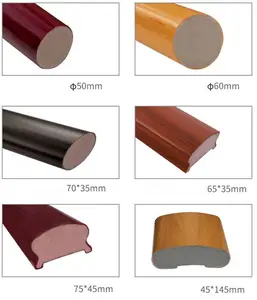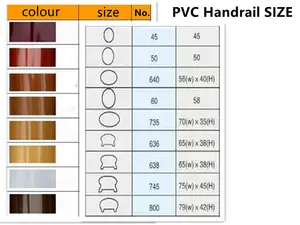(16912 products available)






































































































































































































Wooden handrails are an essential part of any interior or exterior staircase. They are installed for safety and to help people balance while going up or down. However, decorative wood handrails can also be used to add aesthetic value to a home or building. Below are some types of decorative wood handrails:
This is the most common type of handrail, and it is used in many buildings. It is simple and round, and it is easy to hold on to. They are made from different types of strong and durable wood, such as oak, pine, or walnut. These woods are sanded and finished to make the handrail smooth and look good. The round wood handrail is attached to the wall with brackets. The brackets are usually made from the same wood as the handrail and painted or stained to match the color of the handrail. They give support and keep the handrail in place.
This kind of wood handrail is flat on the top. It has a smooth and flat surface that makes it easy to hold on to. The flat handrail design is very modern, and it is often used in modern buildings and houses. The handrail is made from strong wood like oak or pine. The wood is then sanded and stained to make it smooth and give it a nice color. Like the round handrail, flat handrails are also fixed to the wall with brackets. The brackets are strong and keep the handrail in place. They are also painted or stained to match the color of the handrail.
Ebony wood is a type of wood that comes from the ebony tree in Africa. It is one of the most valuable and expensive woods in the world. Ebony wood handrails are used in luxury buildings and homes. The wood is very dark, almost black, and has a smooth finish. It is also very strong and can last for a long time. The handrails are designed to be simple and elegant. They usually don’t have many curves or decorations. But some handrails are carved with traditional African patterns to show the beauty of the wood.
Bentwood handrails are made by bending a long piece of wood into different shapes and sizes. This style of handrail has been used for hundreds of years. The wood is usually steamed or soaked in water to make it soft enough to bend. Then it is bent into the shape of the handrail and left to dry. Once it is dry, the wood is sanded and finished to make the handrail smooth. These handrails can be straight or curved, depending on the design of the staircase.
Wood handrails are essential for safety and support. The functions of decorative wood handrails are as follows:
Decorative wood railings provide a stable handgrip to prevent falls on stairs. It offers a firm grip for support when walking up or down the stairs.
The handrail provides a steady and balanced support for those using the stairs. It is especially important for the elderly, disabled, or people with mobility issues.
Wood handrails offer visual guidance and direction, which is important for emergency situations in public buildings. It also directs people to the right direction when using the staircase.
Features of decorative wood handrails include the following:
Decorative wood handrails are made from different types of wood. Some popular wood handrail types are maple, cherry, oak, mahogany, and walnut. They are well known for their strength and durability. The wood is carefully selected for its quality, and it undergoes treatment to prevent insect attacks and decay. Wooden wall mounted handrail options are popular because of their natural beauty and warmth, and they can be customized to blend with the existing home decor. These wood handrails are easy to maintain and clean.
Wooden wall railings are available in different styles and designs. Some common decorative wood handrail designs are modern, traditional, rustic, and contemporary. They are suitable for any architectural style. These decorative wood handrails can be customized to meet individual needs and preferences. They can add a unique and beautiful look to any space and also improve their aesthetics.
Decorative wood handrails are designed with comfort and safety in mind. They are available in different shapes. Some of the common wood handrail shapes are round, oval, and square. The shape of the handrail is designed to provide a comfortable grip for users. These handrails are smooth and have no sharp edges that can lead to injury. They also have a good finishing touch to prevent slipping.
A decorative wood handrail can add to the beauty of a home's interior. For example, a curved or straight staircase is enhanced by an intricately designed handrail made of wood. The warm, natural tones of wood create a welcoming and cozy atmosphere in the home, especially in the entryway. A decorative wood handrail also provides an important safety feature for stairs while adding to the home's overall appearance.
Decorative wood handrails can also be used in public buildings, like hotels, restaurants, and office buildings. In these settings, decorative wood handrails offer both elegance and security. They can be used to guide guests up the stairs while also giving the space a more refined feel.
Decorative wood railings are also suitable for use in outdoor settings. For example, decks and patios can be lined with decorative wood handrails to connect the outdoor space to the rest of the home. The handrails can be customized to fit the space and make it more visually cohesive.
Decorative wood handrails are a good choice for restoring older buildings to their former grandeur. They can be used to replicate the original wood handrails that may have been in place during the building's prime. This choice maintains historical accuracy in the renovation and preserves the building's original appearance.
Decorative wood handrails can be tailored to meet specific design needs. They can be crafted to create a cohesive look in a particular space. This is because the wood handrails can be customized to fit the exact dimensions of the area where they are installed, ensuring a snug fit. This is especially true for oddly shaped spaces, like those with curved stairs. The decorative wood handrails can be made to follow the exact curve of the staircase, ensuring a seamless and visually appealing look.
When buying decorative wood handrails for stairs, it's important to put several factors into consideration to ensure one gets the right products for their customers. Below are some of the factors:
Decide the type of wood to use in handrails. Popular wood types used in handrails include pine, oak, and maple. Pine is affordable, making it ideal for contractors looking to save money on their projects. However, pine is less durable than other wood types and is prone to scratches and dents. Homeowners looking for a more durable option will prefer maple and oak. These wood types are more expensive but are durable and resistant to damage.
Choose a handrail that matches the aesthetic of the space where it will be installed. Wood comes in various colors and grains, so contractors can find handrails that will blend in well with their customers' spaces. Wood handrails come in various colors, from dark brown to light yellow. They also have different grains, such as fine, straight grain or swirls. Handrails made from oak have a coarse grain and a reddish-brown hue. In contrast, maple has a fine, straight grain and a light color. Wood handrails that feature a light grain are a good choice for small spaces as they make the space appear larger. Those with a dark grain are ideal for large spaces because they make the area feel cozy.
Wood handrails come in different sizes and profiles. Consider the size of the handrail to ensure it's comfortable to hold. The ideal handrail should have a diameter of between 1.25 to 2 inches. Also, choose a handrail with a profile that fits well into the hand. The profile should feel comfortable when someone holds it. Some common handrail profiles include round, oval, and square.
Q1: What is the ideal height for a handrail?
A1: The ideal height is between 34 and 38 inches. The handrail should be at the same level as the armrests of the chair.
Q2: How can you ensure a handrail is safe?
A2: The handrail should extend a few inches beyond the top and bottom steps. The handrail should be continuous. It should be secured to the wall and not loosen. Users should be able to grip the handrail comfortably.
Q3: What is a handrail bracket?
A3: A handrail bracket is a fastener that attaches the rail to the wall. It is used to install the handrail securely.
Q4: Why is the handrail not just a "decorative accent"?
A4: The handrail is crucial for safety. It helps users balance when walking up or downstairs. It also provides support in case of a fall.
Q5: What type of wood is best for a handrail?
A5: Hardwoods like oak and maple are durable. They can withstand frequent use. Softwoods like pine are also popular because they are easy to work with. Each wood has unique grain patterns and colors.